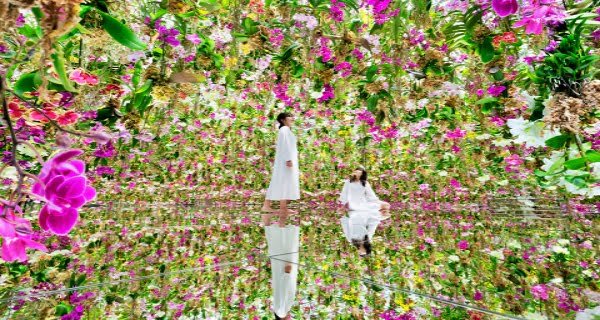
OKYO, Japan: teamLab Planets TOKYO in Toyosu, Tokyo is celebrating its third anniversary with an expansion: on July 2, the museum opens a new Garden Area with two interactive garden artworks.

teamLab, 2015, Interactive Kinetic Installation, Endless, Sound: Hideaki Takahashi (Photo: Business Wire)
Two gardens will open to the public: a garden where visitors can become one with the flowers, immersing themselves in over 13,000 live orchids that bloom in mid-air; and a moss garden filled with ovoids that shine and resonate when pushed by people or blown by the wind.
Consisting of nine artworks, including four gigantic art spaces and two gardens, teamLab Planets transports visitors to an immersive experience in a museum where they walk through water and a garden where they become one with the flowers.
teamLab Planets Highlight Video: https://youtu.be/-uJTk_mRmUY
teamLab Planets
teamLab Planet is a museum where you walk through water and a garden where you become one with the flowers. There are a total of ten artworks, including four massive exhibition spaces and two gardens.
By immersing the entire body with other people in these massive body immersive artworks, the boundary between the body and the artwork dissolves, the boundaries between the self, others, and the world become continuous, and we explore a new relationship without boundaries between ourselves and the world.
Visitors enter the museum barefoot and become completely immersed with other visitors in the vast artwork spaces.
Exhibition Details: planets.teamlab.art/
[Garden Area (2 Garden Artworks)]
Floating Flower Garden; Flowers and I are of the Same Root, the Garden and I are One
teamLab, 2015, Interactive Kinetic Installation, Endless, Sound: Hideaki Takahashi
Artwork: https://planets.teamlab.art/tokyo/ew/ffgarden_planets/
This floating flower garden consists of a three-dimensional mass of flowers.
The flowers float up above people, and when the people move, the flowers descend again. The artwork space is completely filled with flowers, but as they float up, spaces with people at the center are created. Because of this, people are able to freely wander around the three-dimensional flower mass space. If you encounter other people within the artwork, your space will connect with theirs and become one single space.
Zen gardens are said to have been created as a place for groups of Zen priests to carry out training in order to become one with nature. There is a Chinese Zen kōan (a question or story that is part of Zen priests’ theological training) called, “Nansen’s Flower.” A man named Rikukô Taifu, while talking with Nansen, said: “Jô Hoshi says, ‘Heaven and I are of the same root. All things and I are of the same substance.’ How wonderful this is! Nansen, pointing to a flower in the garden said, ‘People these days see this flower as if they were in a dream.’”
In this work, people immerse themselves in flowers, becoming one with the garden. When people become one with the flowers and look at them, the flowers look back. People may truly look at flowers for the first time.
The flowers blooming in the air are epiphytic orchids. Epiphytic plants are extremely common in the orchid family, and epiphytic orchids are able to grow without dirt by absorbing water from the air. The flowers in this artwork are alive, growing, and blooming with each passing day.
Orchids are said to be the last plants to appear on earth. The ground was already covered by other plants, and orchids evolved to live on rocks and trees where other plants could not survive. Orchids adapt and diffuse in a short period of time, and it is said that there are 25,000 to 30,000 kinds of wild species alone. It is believed that there are more types of orchid than any other plant. However, many species are endangered due to the loss of their habitat or overexploitation due to development.
Orchid seeds are as fine as dust, with only immature embryos, no endosperm, and little storage nutrients. In nature, germination of the seed requires symbiosis with a specific fungus, and the symbiotic fungus supplies the nutrients. The seeds have no reserve for germination and cannot sprout themselves, which would seem to contradict the very notion of what a seed is. Seeds should also be a nutrient storehouse for seedlings to germinate, yet the last orchid species to appear on earth has abandoned this aspect. It causes us to wonder why evolution takes certain paths.
Orchids are known to have co-evolved with certain pollen-carrying insects, and it is believed that they continue to evolve rapidly today. The time at which the flowers in the artwork space strengthen in aroma varies according to the time at which these partner insects are active. Because of this, the scent of the artwork space changes each moment between morning, day, and night.


















































